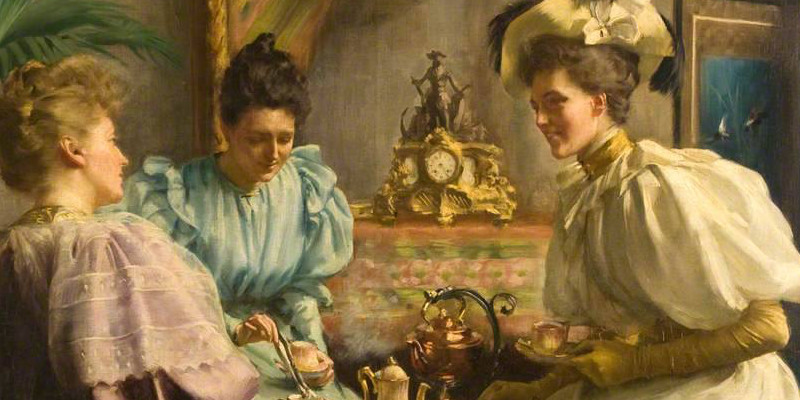Today’s exploration into 19th century beauty features D.G. Brinton, noted physician, archaeologist, and author. Though most of his books focus on ethnicity, we’ll focus on Personal Beauty, published in 1870.
Drawing from both mythological and historical sources, Brinton discusses what make a woman beautiful. A small mouth, upturned nose, and naturally arched brows are some of the key features. But here’s another one: A white complexion.
Some could argue this is personal preference. Brinton’s views on race are widely known, however, as he staunchly believed in scientific racism. He viewed beauty through narrow binoculars, only giving credence to Eurocentric beauty standards.
In 1895, while serving as professor of linguistics and archaeology at the University of Pennsylvania, he said the following:

These views, unsurprisingly, are reflected in Personal Beauty. In Chapter I, The Beauty of the Face, Brinton proclaims that “the more closely an Englishwoman, a Frenchwoman, a German woman, or a person of any other caucasian nation resemble these Greek models both in form and features, the more beautiful she may be considered to be.”
What praise has he to offer women who are not white? None at all. In the same chapter, he mentions the oblique, almond-shaped eyes of the Chinese and Japanese being “repulsive to the European tastes.” Oblique, in this context, meaning slanted.
Suffice to say, I’m no beauty in his eyes. According to his “research” – I’ll use that term loosely, as it’s cherry picked to prioritize Eurocentric sources – this is how I should look, ideally.

The changes made include:
- A small, wrinkle-free forehead. A high forehead was considered a deformity, though the actual sources for this are vague. Brinton’s personal preferences are plainly seen on page 9, where he writes “some folks of both sexes acquire an idiotic and supercilious habit of lifting their eyebrows during conversation,” creating wrinkles across the forehead, which he deems unattractive.
- Fuller, well-arched eyebrows placed lower on the forehead. Good eyebrows should be “furnished with fine soft hair, not too thick,” with a fine arch that doesn’t separate too far from the eyelids. My actual eyebrows are shaved at the ends, so a little photoshop magic helped thicken them.
- Eyes with a gentle curve and an open expression. Eyes that are “well opened,” instead of droopy or squinty, express the woman’s honest self. Round, gently curved eyelids are ideal, whereas small or almond-shaped eyes, which he associates with Japanese and Chinese women, are “repulsive.”
- Round, dimpled cheeks are the loveliest. For everyone’s sake I did not attempt to draw dimples on myself, but opted for more fullness. No real explanation for this other that “poets love the dimple.”
- Brinton isn’t as clear about nose preferences. He favors two types: The classic Grecian nose and a small up-turned nose. That isn’t too far off from my own nose shape, although I wouldn’t consider it small in any sense.
- A small mouth and full lips are desirable. Oddly enough, Brinton goes into great detail here, pointing out that the most beautiful mouths are the width of a woman’s nostrils. The lips should curve gently, with a full under lip, as thin lips are not “agreeable or kissable.”
The result of this is, unsurprisingly, frightening and unnatural on me. My skin is also lightened to a milky white to fit the beauty standards of that time. But alas, my natural features are, as Brinton says, repulsive. He favors Caucasian features that are delicate and also physically impossible for most white women to obtain. He admits this: On page 12, he says “few Englishwoman even have mouths so small as this.”
These idealized features differ greatly from today, which undoubtedly are not only influenced by trends, but features associated with other races.
But as antiquated as these beauty standards are, it’s an important glimpse into 19th century history. More importantly, it shows how “scientific minds” can form their own biases, convincing themselves that their conclusions are rational.
It also reveals that, apparently, men think themselves the proper authority to deem what makes a woman beautiful. I haven’t come across a 19th century book on beauty thus far authored by a woman – imagine that! Brinton himself doesn’t have anything to say about male beauty; I can’t imagine why, as I’m sure he was the pinnacle of masculinity with his beady eyes and receding hairline.
Anyways, I’m off to read more books – perhaps with more variety, as I want to know what actual women believed during this time.


This was very insightful!! I had the same thoughts running through my head with the broad question,” what makes a woman beautiful in each race?” I think to a specific scientific viewpoint on each feature and why it is deemed beautiful. I am Latina and it’s can be quite difficult to pinpoint certain features.